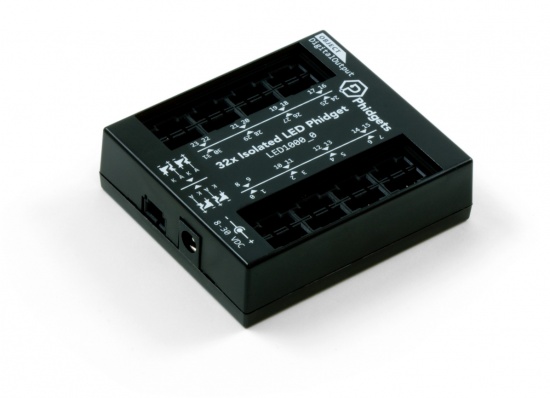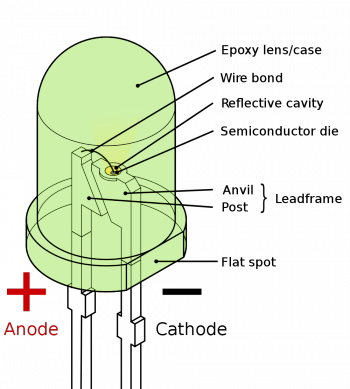LED Guide: Difference between revisions
No edit summary |
No edit summary |
||
| (32 intermediate revisions by 4 users not shown) | |||
| Line 1: | Line 1: | ||
{{#seo:|description=Interested in controlling LEDs with Phidgets? Check out this guide for information about how to control LEDs, what interfaces to use, and more.}} | |||
{{#seo:|keywords=LED}} | |||
[[Category:IntroGuide]] | |||
| | __TOC__ | ||
| | |||
<br clear="all" /> | <br clear="all" /> | ||
==Introduction== | ==Introduction== | ||
[[File:LED1000_0.jpg|link=|right|550px]] | |||
Like normal diodes, Light Emitting Diodes (LEDs) are semiconductor devices designed to conduct current in one direction only. What makes LEDs unique is their internal material makeup: when atoms in an LED release energy due to the flow of forward current, it is released in the form of photons (light). Different construction materials and various phosphor coatings are used to produce numerous colors of light. | |||
The best way to drive a large number of LEDS is with one of our LED controllers: | |||
* [{{SERVER}}/products.php?product_id=1032 1032 - PhidgetLED-64 Advanced] | |||
* [{{SERVER}}/products.php?product_id=LED1000 LED1000 - 32x Isolated LED Phidget] | |||
These boards offer multiple channels, brightness control, current control, and even forward voltage control! It is clear why you would want to use one of these instead of a regular digital output. | |||
==How it works== | ==How it works== | ||
| Line 23: | Line 24: | ||
===Forward Voltage=== | ===Forward Voltage=== | ||
The materials used within LEDs that cause them to emit different colors of light affect a property called its forward voltage. The forward voltage is the voltage at which current in the forward direction will flow through the device and allow the LED to convert electrical energy into light. If the voltage applied to the LED is below the forward voltage of the LED, very little current (or none) may flow, and therefore very little light will be emitted. Most standard LEDs with colors such as red, amber, orange, yellow, and green have forward voltages below 2.75 Volts, and can be used with a [[Digital | The materials used within LEDs that cause them to emit different colors of light affect a property called its forward voltage. The forward voltage is the voltage at which current in the forward direction will flow through the device and allow the LED to convert electrical energy into light. If the voltage applied to the LED is below the forward voltage of the LED, very little current (or none) may flow, and therefore very little light will be emitted. Most standard LEDs with colors such as red, amber, orange, yellow, and green have forward voltages below 2.75 Volts, and can be used with a [[InterfaceKit Digital Outputs|digital output]] or {{VINTHub}} port in DigitalOutput mode by simply soldering the LED to a connector-wire or Phidget cable and inserting the wire or cable into the output port. To see which forward voltage settings are supported by your Phidget, have a look at the {{Code|LEDForwardVoltage}} enumeration in the {{Phidget22API}}. | ||
===Supply Voltage=== | ===Supply Voltage=== | ||
To be an effective LED controller your digital outputs must be capable of adjusting the forward voltage supplied to the LEDs to various settings allowing you to properly drive blue, white, violet, ultra violet and purple LEDs. The supply voltage will affect all LEDs. If you set the supplied voltage too high, power will be wasted and the controller may shut down from thermal overload. If you set the supply voltage too low, your LEDs will not be driven at the requested current, and will be dim or non-functional. | |||
{|class="wikitable" style="text-align: center;width:50%;margin:auto" | |||
|colspan="2" style="background:#f0f0f0;"|'''Typical Forward Voltages''' | |||
{| | |||
|- | |- | ||
| | |style="background:#f0f0f0;"|'''Color''' | ||
| | |style="background:#f0f0f0;"|'''Forward Voltage''' | ||
|- | |- | ||
| Infrared||< 1.9 | |Infrared||< 1.9 | ||
|- | |- | ||
| Red||1.7 to 2.2 | |Red||1.7 to 2.2 | ||
|- | |- | ||
| Orange||2.0 to 2.2 | |Orange||2.0 to 2.2 | ||
|- | |- | ||
| Yellow||2.1 to 2.4 | |Yellow||2.1 to 2.4 | ||
|- | |- | ||
| Green||2 to 2.3 | |Green||2 to 2.3 | ||
|- | |- | ||
| Blue||3.2 to 4.0 | |Blue||3.2 to 4.0 | ||
|- | |- | ||
| Ultraviolet||2.1 to 3.8 | |Ultraviolet||2.1 to 3.8 | ||
|- | |- | ||
| White||3.3 to 3.6 | |White||3.3 to 3.6 | ||
|} | |} | ||
===Maximum Current and Brightness Control=== | ===Maximum Current and Brightness Control=== | ||
Most LEDs have a current rating of 20, 40, 60 or 80mA. Our dedicated {{CT|LEDInterface|LED Phidgets}} can adjust the current limit or brightness (duty cycle). This however does not imply a precise method for controlling the visibility of emitted light, since this is affected by the construction and quality of the LED as well as the eyes of the viewer. That is to say, a 50% change in duty cycle does not necessarily result in a 50% change in visible brightness. Be cautious when changing the current limit; many small LEDs are designed for a low maximum current, and can burn out if driven at higher currents. | |||
Most LEDs | |||
===Choosing Current and Voltage Settings=== | ===Choosing Current and Voltage Settings=== | ||
Make sure to choose the minimum supply voltage setting to drive the LED that requires the most voltage during operation. Any extra voltage not required by the LED will be converted to heat by the Phidget. For example, a Blue LED being driven at 20mA, 3.9V Supply, that requires 3.7 volts will cause (3.9V-3.7V + 0.4V) * 0.02A = 12 milliwatts of heat to be produced. If this example instead uses a high power, 1.5V infrared LED at 80mA, this will create (3.9V-1.5V+0.4V)*0.08 Amps = 224 milliwatts of heat. | |||
Make sure to choose the minimum supply voltage setting to drive the LED that requires the most voltage during operation. Any extra voltage not required by the LED will be converted to heat by the | |||
==Other uses for LED controllers== | ==Other uses for LED controllers== | ||
LED controllers are typically just a set of special digital outputs. This means they aren't limited to just controlling LEDs. They can be used to control relays, solenoids and even very small motors. LED Phidgets can also be used to drive opto-isolators and MOSFET SSRs. | |||
LED controllers are typically just a set of special digital outputs. | |||
Latest revision as of 20:08, 26 June 2023
Introduction

Like normal diodes, Light Emitting Diodes (LEDs) are semiconductor devices designed to conduct current in one direction only. What makes LEDs unique is their internal material makeup: when atoms in an LED release energy due to the flow of forward current, it is released in the form of photons (light). Different construction materials and various phosphor coatings are used to produce numerous colors of light.
The best way to drive a large number of LEDS is with one of our LED controllers:
These boards offer multiple channels, brightness control, current control, and even forward voltage control! It is clear why you would want to use one of these instead of a regular digital output.
How it works
LEDs emit light from current flowing through them. As the current flows, the electronics experience a sudden drop in energy level (voltage). When that happens they release energy in the form of light. The amount of light produced is proportional to the current. Depending on the material used to make the LED, different colors can be created. Like a conventional diode, the current can only flow in one direction - from the anode to the cathode.
Controlling LEDs
Forward Voltage
The materials used within LEDs that cause them to emit different colors of light affect a property called its forward voltage. The forward voltage is the voltage at which current in the forward direction will flow through the device and allow the LED to convert electrical energy into light. If the voltage applied to the LED is below the forward voltage of the LED, very little current (or none) may flow, and therefore very little light will be emitted. Most standard LEDs with colors such as red, amber, orange, yellow, and green have forward voltages below 2.75 Volts, and can be used with a digital output or VINT Hub port in DigitalOutput mode by simply soldering the LED to a connector-wire or Phidget cable and inserting the wire or cable into the output port. To see which forward voltage settings are supported by your Phidget, have a look at the LEDForwardVoltage enumeration in the Phidget22 API.
Supply Voltage
To be an effective LED controller your digital outputs must be capable of adjusting the forward voltage supplied to the LEDs to various settings allowing you to properly drive blue, white, violet, ultra violet and purple LEDs. The supply voltage will affect all LEDs. If you set the supplied voltage too high, power will be wasted and the controller may shut down from thermal overload. If you set the supply voltage too low, your LEDs will not be driven at the requested current, and will be dim or non-functional.
| Typical Forward Voltages | |
| Color | Forward Voltage |
| Infrared | < 1.9 |
| Red | 1.7 to 2.2 |
| Orange | 2.0 to 2.2 |
| Yellow | 2.1 to 2.4 |
| Green | 2 to 2.3 |
| Blue | 3.2 to 4.0 |
| Ultraviolet | 2.1 to 3.8 |
| White | 3.3 to 3.6 |
Maximum Current and Brightness Control
Most LEDs have a current rating of 20, 40, 60 or 80mA. Our dedicated LED Phidgets can adjust the current limit or brightness (duty cycle). This however does not imply a precise method for controlling the visibility of emitted light, since this is affected by the construction and quality of the LED as well as the eyes of the viewer. That is to say, a 50% change in duty cycle does not necessarily result in a 50% change in visible brightness. Be cautious when changing the current limit; many small LEDs are designed for a low maximum current, and can burn out if driven at higher currents.
Choosing Current and Voltage Settings
Make sure to choose the minimum supply voltage setting to drive the LED that requires the most voltage during operation. Any extra voltage not required by the LED will be converted to heat by the Phidget. For example, a Blue LED being driven at 20mA, 3.9V Supply, that requires 3.7 volts will cause (3.9V-3.7V + 0.4V) * 0.02A = 12 milliwatts of heat to be produced. If this example instead uses a high power, 1.5V infrared LED at 80mA, this will create (3.9V-1.5V+0.4V)*0.08 Amps = 224 milliwatts of heat.
Other uses for LED controllers
LED controllers are typically just a set of special digital outputs. This means they aren't limited to just controlling LEDs. They can be used to control relays, solenoids and even very small motors. LED Phidgets can also be used to drive opto-isolators and MOSFET SSRs.

